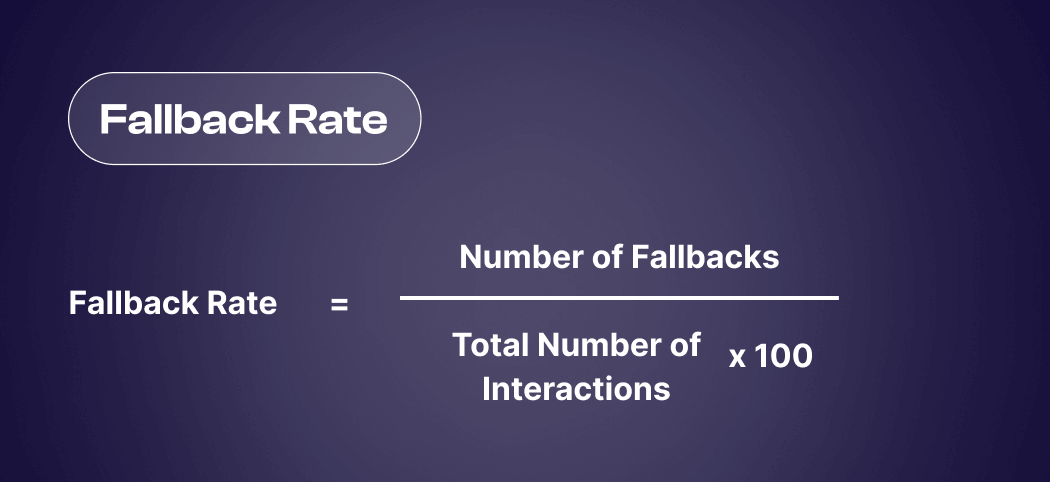While fallback messages are a must have for any chatbot. It cannot be measured. To understand the effectiveness of an AI chatbot in regards to fallback messages, customer support and product leaders use fallback rate as a key KPI to measure the chatbot effectiveness. We will discuss in detail what fallback rate is and how it can be improved, but first let’s discuss how human-handoff can be the ultimate savior for any customer service team.
What is Fallback Message?

What is Chatbot Fallback Rate?
Fallback rate refers to the percentage of interactions in which a chatbot fails to understand the user's intent and resorts to a fallback response. These fallback responses are pre-programmed messages that a chatbot uses when it encounters input it cannot process or understand correctly. For example, a typical fallback response might be, "I'm sorry, I didn't understand that. Could you please rephrase it?" or "I'm here to help! Could you clarify your question?"
The fallback rate is calculated using the following formula:
Fallback Rate (%) = (Number of Fallbacks / Total Number of Interactions) * 100
A high fallback rate indicates that the chatbot is frequently unable to comprehend user inputs, leading to user frustration and poor experience.

Why is Fallback Rate Important?
The fallback rate is a vital metric for several reasons:
User Experience
A high fallback rate often correlates with a frustrating user experience. Users expect quick, accurate, and helpful responses from chatbots. When a chatbot frequently fails to understand queries, it disrupts the flow of interaction and diminishes the user's confidence in the technology.Performance Indicator
Monitoring the fallback rate helps developers and businesses gauge the performance of their chatbot. It acts as a diagnostic tool, pointing to areas where the chatbot's natural language processing (NLP) capabilities may be lacking.Cost Implications
In customer service, unresolved queries due to a high fallback rate often lead to escalations to human agents. This not only increases operational costs but can also slow down response times, affecting overall customer satisfaction.Continuous Improvement
By tracking the fallback rate, teams can prioritize improvements in the chatbot’s training data, fine-tuning its algorithms to better understand and respond to user inputs over time.
How to Improve Fallback Rate?
Improving the fallback rate involves several strategies:
Enhanced Training Data
Regularly updating and expanding the training data used to develop the chatbot's NLP capabilities can help it understand a wider variety of user inputs. This includes incorporating diverse language patterns, synonyms, and contextual variations.Contextual Understanding
Implementing advanced NLP techniques that focus on understanding the context of a conversation can reduce the fallback rate. By recognizing user intent based on the context, chatbots can provide more accurate responses.User Feedback Loops
Actively gathering and analyzing user feedback on fallback responses can highlight common issues and help developers refine the chatbot's understanding of specific queries.Multi-turn Conversations
Designing the chatbot to handle multi-turn conversations (where the bot can ask follow-up questions to clarify user intent) can reduce the likelihood of fallbacks.Regular Audits and Testing
Continuous testing and auditing of the chatbot's performance in real-world scenarios allow teams to identify and address issues before they affect end-users.
Replace Fallback Messages with Human Handoff for Better Customer Experience
A human handoff is the process of transferring the query from the AI chatbot to a live agent for further assistance. Human handoff is extremely useful when a customer needs immediate human assistance. Human handoff elevates the ultimate experience of a customer. With Kommunicate’s chatbot, fallback messages can be replaced with human handoff.
Below is an example of a fallback message in Kommunicate:
"I’m sorry, I don’t know the answer to your question. I’m transferring your query to one of our live agents to assist you immediately.”
By transferring the conversation to a live agent, the customer can quickly get answers to their query.
Now let’s dig deeper into fallback rate and why it is a vital KPI metric for any customer service leader.
Beyond Fallback Rate: Other Metrics to Analyze
While fallback rate is a critical metric, it’s not the only one that determines a chatbot’s success. Here are other important metrics to consider:
Containment Rate
Measures the percentage of interactions that the chatbot successfully handles without requiring human intervention. A high containment rate, coupled with a low fallback rate, indicates a well-performing chatbot.Resolution Rate
The percentage of queries that are resolved by the chatbot without further escalation. This metric directly correlates with customer satisfaction.Customer Satisfaction (CSAT)
Gathering user feedback after interactions provides insights into how satisfied users are with the chatbot's performance. This can be measured using surveys or ratings.First Response Time (FRT)
The time it takes for the chatbot to provide its first response to a user's query. A faster FRT can enhance the user experience by providing timely assistance.Retention Rate
The percentage of users who return to use the chatbot after their first interaction. A high retention rate suggests that users find the chatbot helpful and are willing to use it again.
In the AI chatbot industry, understanding and optimizing the fallback message and fallback rate is essential for ensuring a seamless user experience. By focusing on reducing the fallback rate and simultaneously monitoring other key metrics like containment rate, resolution rate, and customer satisfaction, businesses can enhance their chatbot's performance and, ultimately, their customer service quality.
Whether you're developing a chatbot for customer support, sales, or any other application, keeping a close eye on these metrics will guide you towards creating a more effective and user-friendly AI solution.
